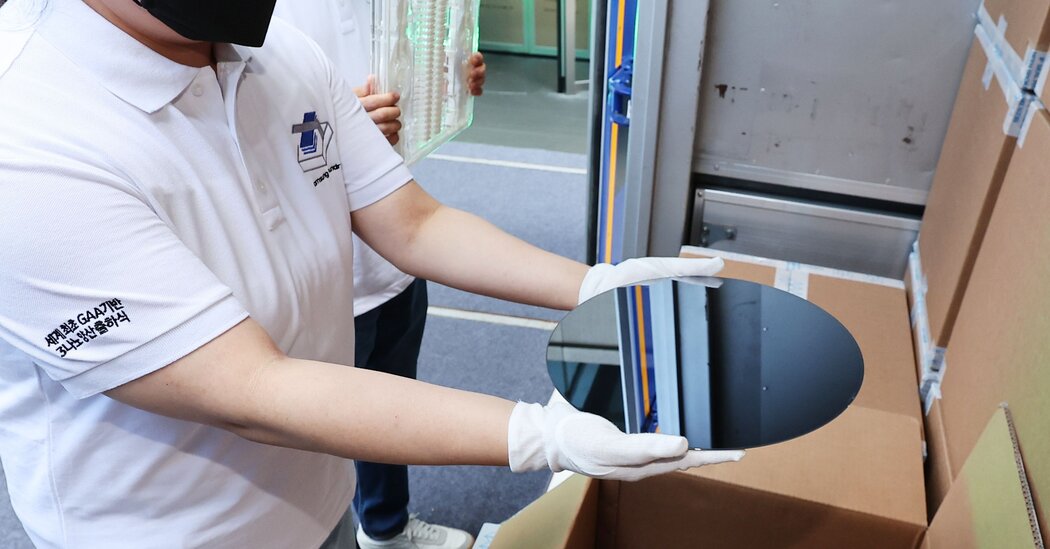The introduction of ChatGPT has lit a fire among the stocks of companies that produce microchips, the brains of artificial intelligence. Bets on the potential of so-called generative AI are pouring in. The most glaring example of the rally is Silicon Valley-based Nvidia, the best-seller of chips used in artificial intelligence, whose shares are up nearly 200 percent this year.
Samsung Electronics, the South Korean giant, hopes to take action. Widely known for its consumer products, Samsung also has the world’s largest memory chip company and second busiest semiconductor foundries, building custom microchips for other companies.
Foreign investors have bought $8 billion worth of Samsung stock on the South Korean stock market this year — already the largest number of foreign purchases in Samsung since 2000, according to data from CLSA, a Hong Kong investment firm. The wave ended a sell-off of the past three years when foreign investors sold more of the company’s shares than they bought.
At an event in California last week, Samsung detailed what it called its “vision in the AI era.” Samsung believes it can take market share from the leading chip maker, Taiwan Semiconductor Manufacturing Company, but lately the trend has turned the other way. According to Counterpoint Research, a market research firm, TSMC enjoys about 60 percent of total revenue in the global foundry sector and Samsung only 13 percent — a gap that has widened since 2021 as some of Samsung’s customers, including Nvidia, have shifted their operations to TSMC.
Samsung said it spent $7.4 billion in the first quarter of this year — when profits fell by as much as 95 percent — on its chip business, part of which is expected to serve the AI industry. It is expanding production at its chip manufacturing complex in Pyeongtaek, about 40 miles south of Seoul, as well as a chip factory in Texas. In the next 20 years, Samsung said, it plans to work with the government on a $230 billion plan to build a chip-making “megacluster” in South Korea.
The optimism is linked to Samsung’s memory chip business, which accounts for about half of the company’s operating profit in an average year, said Sanjeev Rana, a senior analyst at CLSA.
Compared to traditional servers – the hardware that underpins desktops and databases – the servers built for artificial intelligence can require four times the amount of memory, called DRAM. Samsung controls about 45 percent of the global DRAM market. And it is the only major memory company to invest in more production despite an industry-wide drop in memory prices, Mr Rana added.
The chip industry is known for its boom-and-bust cycles. After a spike in demand for memory chips during the pandemic, chipmakers entered one of their worst downturns in years last fall. Samsung’s memory chip rivals, including Micron Technology in the United States and SK Hynix in South Korea, said they would cut production investments this year.
Some analysts believe that Samsung’s downcycle spending will pay off in the long run as the memory sector recovers, thanks in part to artificial intelligence.
“When the demand comes back, they will be ready for it,” said Mr Rana.
But skeptics question whether Samsung can play the indispensable role in generative AI it has had in smartphones and high-resolution TVs. It lost last year when Nvidia chose SK Hynix as the supplier for a high-performance memory chip that is expected to become a fast-growing business line due to its prominence in future AI servers.
According to market research firm TrendForce, SK Hynix controls about 50 percent of that market for high-bandwidth memory, or HBM, compared to Samsung’s 40 percent. Shares of SK Hynix are up more than 50 percent this year, outpacing Samsung’s gains by 30 percent.
Samsung said it had already started supplying “key customers” with a competing version of HBM. The next generation of its HBM will be launched this year, he added.
Samsung’s backlog in HBM technology could be a symptom of broader problems, said Nam Hyung Kim, an analyst at Arete Research, an equity research firm. In a report in February, Mr. Kim wrote that Micron had also skipped Samsung’s technology in DRAM and another type of memory, NAND flash.
“The problem with Samsung is that they always want to be big,” said Mr. Kim. “They’re spending so much money, but they’re not the technology leader anymore.”
Mr. Kim said that Samsung should invest more in research and not worry so much about market share. “Samsung is a bigger player than Apple in the smartphone space,” he said. “But how many people think Samsung makes a better smartphone than Apple?”
Samsung said in a statement that it was successful in several aspects of advanced semiconductor technologies and was able to provide customers with “comprehensive solutions” in the evolving landscape of AI and other technologies.
Samsung’s own executives have made a more sober diagnosis.
In May, the president of Samsung’s semiconductor division, Kyung Kye-hyun, acknowledged in a conversation with university students that the company was up to two years behind TSMC. The comments, which circulated widely in the Korean media, were a rare admission for a company that has long prided itself on its technology leadership.
Mr Kyung further promised that Samsung’s memory chips would become a “core” of AI supercomputers by 2028. “We can surpass TSMC in five years,” he said.
Jin Yu Young reporting contributed.

